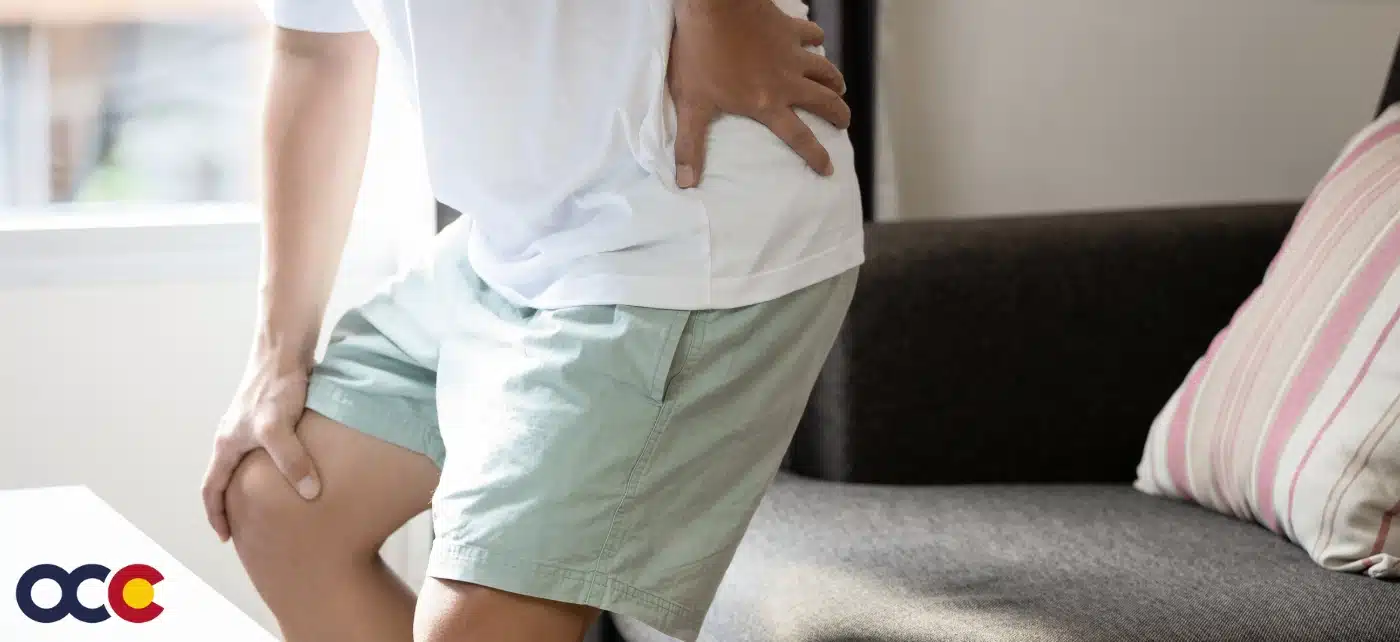Sciatica refers to pain, weakness, numbness, or tingling in the leg. It is caused by injury to the sciatic nerve. This pain can disrupt your life in many ways. Sciatica is a symptom of a medical problem like a herniated disc or spinal stenosis. Many contributing factors may increase your risk of sciatica. Nerve pain can be difficult to treat, which is why you should see experienced orthopedic specialists right away, like those at Advanced Orthopedic & Sports Medicine Specialists in Denver, Parker, or Aurora, Colorado. You don’t want to wait until your pain becomes debilitating.
OVERVIEW
Also called lumbar radiculopathy, sciatica is a symptom of a medical problem, not a medical condition by itself. Having sciatica means one can experience mild to severe pain anywhere nerves connect to the sciatic nerve. The symptoms can affect the lower back, hips, buttocks, or legs. Some symptoms may extend as far down as the feet and toes, depending on the specific nerve or nerves affected. Sciatica is a very common condition. About 40% of people in the U.S. experience some form of sciatica in their lifetime. Men experience sciatica three times more often than women. Sciatica is most common in adults in their 40s and 50s, and it rarely happens before the age of 20 unless it is injury-related. Some causes of sciatica are preventable, but others happen unpredictably or for unknown reasons. Sciatica usually only affects one leg at a time; however, it can occur in both legs in rare cases.
ABOUT THE SCIATIC NERVE
The sciatic nerve is the longest and thickest in the body and the main nerve in the leg. It is formed by the combination of nerve roots that exit the spine in the lower back. There are two sciatic nerves, one on each side of the body. Each runs through the hip and buttock on one side. They go down the leg on the side of the body until they reach just below the knee. Once there, they split into other nerves that connect to parts further down, including the lower leg, foot, and toes. The sciatic nerve plays a crucial role in transmitting signals between the spinal cord and the muscles of the lower extremities. It is responsible for motor function (muscle movement) and sensation (feeling).
WHAT IS SCIATICA?
Sciatica is when irritation, inflammation, pinching, or compression affects one or more nerves that run down the lower back and into the legs, causing pain and other problems. There are two types of sciatica: true sciatica, which is any condition or injury that directly affects the sciatic nerve, or sciatica-like conditions, which feel like sciatic but happen for other reasons related to the sciatic nerve or the nerves that bundle together to it. Regardless of the type, the effects are the same. There are four different types of sciatic nerve pain: acute, chronic, alternating, and bilateral.
CAUSES
There is a long list of conditions that can cause sciatica:
- Slipped or herniated disk
- Degenerative disk disease
- Spinal stenosis
- Spondylolisthesis
- Current or previous injury
- Pregnancy
- Tumors, cysts, or other growths
- Osteoarthritis
- Normal wear and tear that comes with aging
- Excess weight or obesity
- Insufficient core strength
- Poor posture
- Physical inactivity
- Type 2 diabetes
- Jobs that require heavy lifting, a lot of bending or working in awkward positions, or prolonged sitting
SYMPTOMS
Pain: most people describe sciatica pain as burning or like an electric shock. This pain also often shoots or radiates down the leg on the affected side. There can be lower back pain, hip pain, and constant pain on one side of the rear. Pain commonly happens with coughing, sneezing, bending, or lifting your legs upward when lying on the back. This pain may become chronic and long-term.
Tingling or “pins and needles” (paresthesia): this is similar to the feeling one has when a leg falls asleep because of sitting cross-legged.
Numbness: when unable to feel sensations on the skin in the affected areas of the back or leg. This happens because signals from the back or leg are having trouble reaching the brain.
Muscle weakness: this is a more severe symptom. It means that muscle command signals are having through reaching their destination in the back or legs. Sometimes the foot gets caught on the ground when walking, a condition called “drop foot.”
Urinary or fecal incontinence: this is a very severe symptom. It means signals that control the bladder and bowels aren’t reaching their destinations.
Antalgic gait: where stride length is adjusted in response to pain, resulting in a limp.
NON-SURGICAL TREATMENT
Conservative treatment is best in many cases. Measures to take care of the back at home may include applying heat or ice to the painful area. Try ice for the first 48 to 72 hours, then use heat. Take over-the-counter pain relievers such as ibuprofen (Advil) or acetaminophen (Tylenol). A healthcare provider may suggest physical therapy. Bed rest is NOT recommended. If these treatments do not help, painkillers, muscle relaxants, and other medications may be prescribed. Spinal injections like corticosteroids may provide short-term relief (typically up to three months).
WHEN IS SURGERY INDICATED?
Surgery is usually the last resort for treatment unless symptoms don’t improve after six to eight weeks of conservative treatment. Some common indications for surgery include severe or progressive neurological deficits such as muscle weakness, loss of sensation or bowel/bladder dysfunction, persisting symptoms, structural issues such as a herniated disc, Cauda Equina Syndrome, which is a rare but serious condition where there is significant compression and reoccurring episodes.
GETTING THE RIGHT DIAGNOSIS. GETTING THE RIGHT DOCTOR.
If severe pain and dysfunction prevent you from working or going about your usual routine, it’s time to get the level of professional help you’ll find at Advanced Orthopedics in Denver, Parker, or Aurora, Colorado. Their orthopedic specialists use advanced technology, sophisticated imaging tests, and a comprehensive examination to obtain a detailed, accurate diagnosis of your condition to create the best overall treatment plan. As sciatica is a symptom of a more specific medical condition, it takes an expert with extensive experience treating it to identify the underlying cause. Several tests can help with sciatica and rule out similar conditions. The most likely tests include but aren’t limited to spine X-rays or CT or MRI scans, nerve conduction velocity studies, electromyography, and myelograms. Your caring, knowledgeable doctor at Advanced Orthopedics will explain everything in detail, answer all your questions, and discuss all the best options for getting you back to yourself and back to life. If you think you are experiencing Sciatica, schedule an appointment today.









